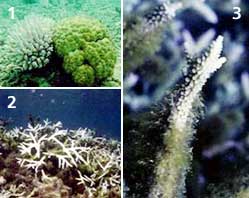This complex theme deals primarily with interactions between organisms and the environmental factors that impact them, but to a greater extent between individual inanimate environmental factors.
innovations-report offers informative reports and articles on topics such as climate protection, landscape conservation, ecological systems, wildlife and nature parks and ecosystem efficiency and balance.

In an important new study directly linking climatic warming with the survival of lake organisms, researchers have found multiple lines of evidence showing that increasing air and water temperatures and related factors are shrinking fish and algae populations in a major lake. The lake holds 18 percent of the world’s liquid freshwater and is a critical food source in East Africa.
Reporting in the August 14, 2003, issue of the journal Nature, Catherine O’Reilly of Vassar College, Andrew Cohe

When Miss Pearl finally returned to the Pearl Cays in Nicaragua last month after a three-year hiatus, it was cause for celebration. Best of all, her transmitter was still attached.
Named by local Nicaraguan participants and scientists from the New York-based Wildlife Conservation Society (WCS), Miss Pearl is a female hawksbill sea turtle, one of the most endangered of this ancient tribe of sea-going reptiles. In 2000, she had already distinguished herself by traveling farther than any other

Hundreds of species with small ranges seen vulnerable
The Caribbean Sea has the greatest concentration of marine life in the entire Atlantic and is home to hundreds of species that live only in precariously small areas, making life there far richer and more delicate than previously thought, according to a new study.
An analysis of the ranges of 1,172 marine species revealed that some 253, or 22 percent, are endemic to the Caribbean region, meaning they are found nowhere else

A team of scientists, including several from the National Center for Atmospheric Research (NCAR), has determined that human-related emissions are largely responsible for an increase in the height of the tropopause – the boundary between the two lowest layers of the atmosphere. The research results, which will be published July 25 in the journal Science, provide additional evidence that emissions from power plants, automobiles, and other human-related (or anthropogenic) sources are having profound im

While the high ocean surface temperatures during the 1997-98 El Nino bleached coral reefs in more than 50 tropical countries worldwide, patches of coral did survive in or near the damaged reefs. A new study of these patches identifies factors likely to protect these threatened marine ecosystems during climate change.
“As baseline sea surface temperatures continue to rise, climate change may represent the single greatest threat to coral reefs worldwide,” say Jordan West of the U.S. En

While European environmentalists see quarries as scars in the Earth, these industrial operations may actually play a critical role in preserving rare species. New research shows that quarries provide the only suitable habitat for at-risk butterflies in some places, suggesting that current policies of filling in old quarries are misguided.
“Increasing evidence is revealing the counterproductivity of such practices,” say Jiri Benes, Pavel Kepka and Martin Konvicka, all of the University of So